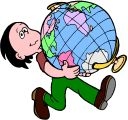
Worksheets and No Prep Teaching Resources
Reading Comprehension Worksheets
Geography

Geography
 Worksheets and No Prep Teaching Resources Reading Comprehension Worksheets Geography |
 Geography |
| edHelper's suggested reading level: | grades 6 to 8 | |
| Flesch-Kincaid grade level: | 7.67 |
|
Projecting the World
By Trista L. Pollard |

|
 1 Years after agreeing that the Earth is a sphere, cartographers and scientists continue to map its surface. Early mapmakers relied on information from sailors and explorers. Today, they use computers, satellites, and cameras to get information about Earth. One tough task still remains. How do you make an accurate flat map out of a sphere? Gerdhaus Mercator had the right idea. He introduced one of the first map projections.
1 Years after agreeing that the Earth is a sphere, cartographers and scientists continue to map its surface. Early mapmakers relied on information from sailors and explorers. Today, they use computers, satellites, and cameras to get information about Earth. One tough task still remains. How do you make an accurate flat map out of a sphere? Gerdhaus Mercator had the right idea. He introduced one of the first map projections. |
Create Weekly Reading Books
Prepare for an entire week at once! |
| Leave your feedback on Projecting the World (use this link if you found an error in the story) |
 |
Geography
|